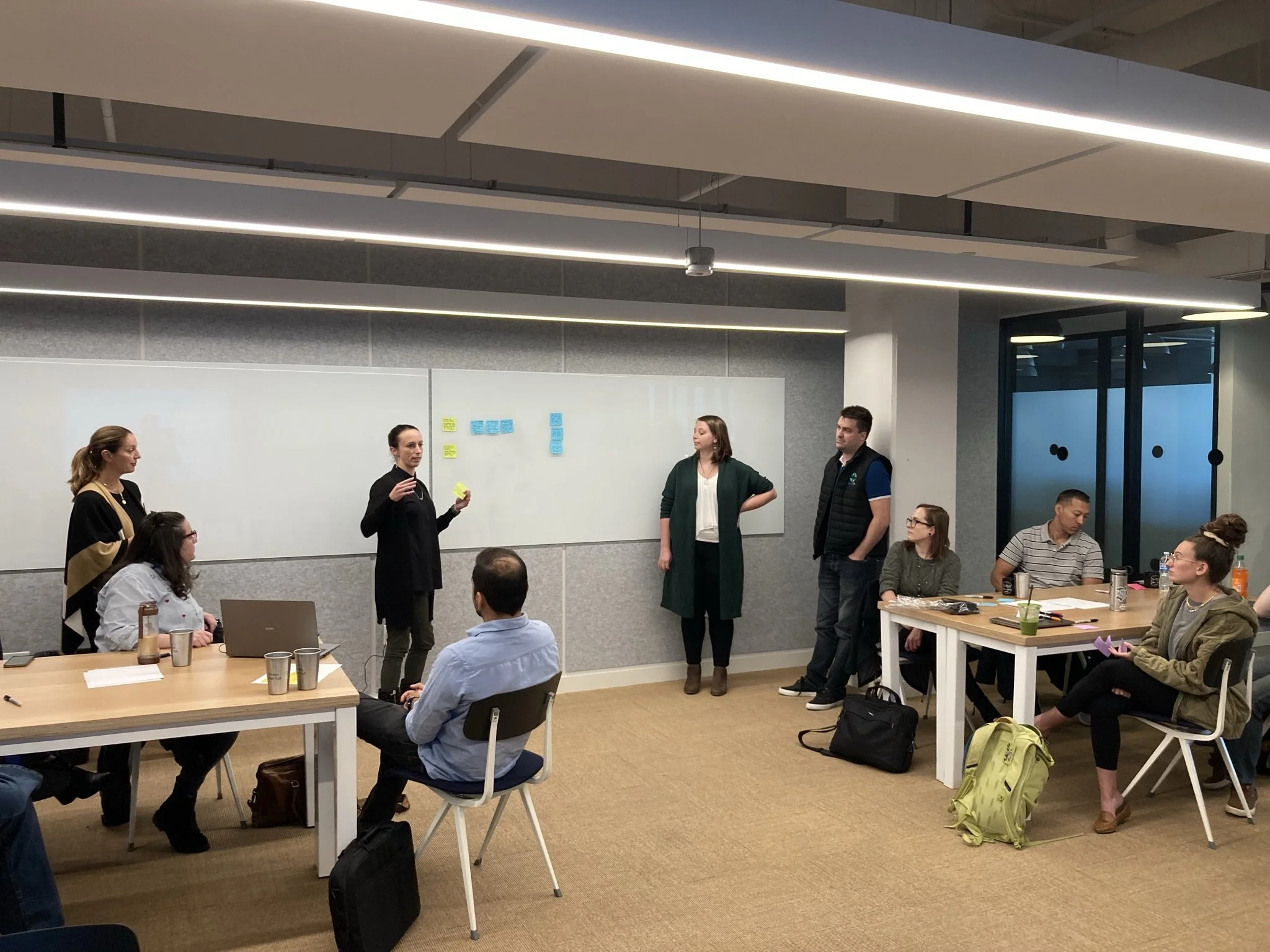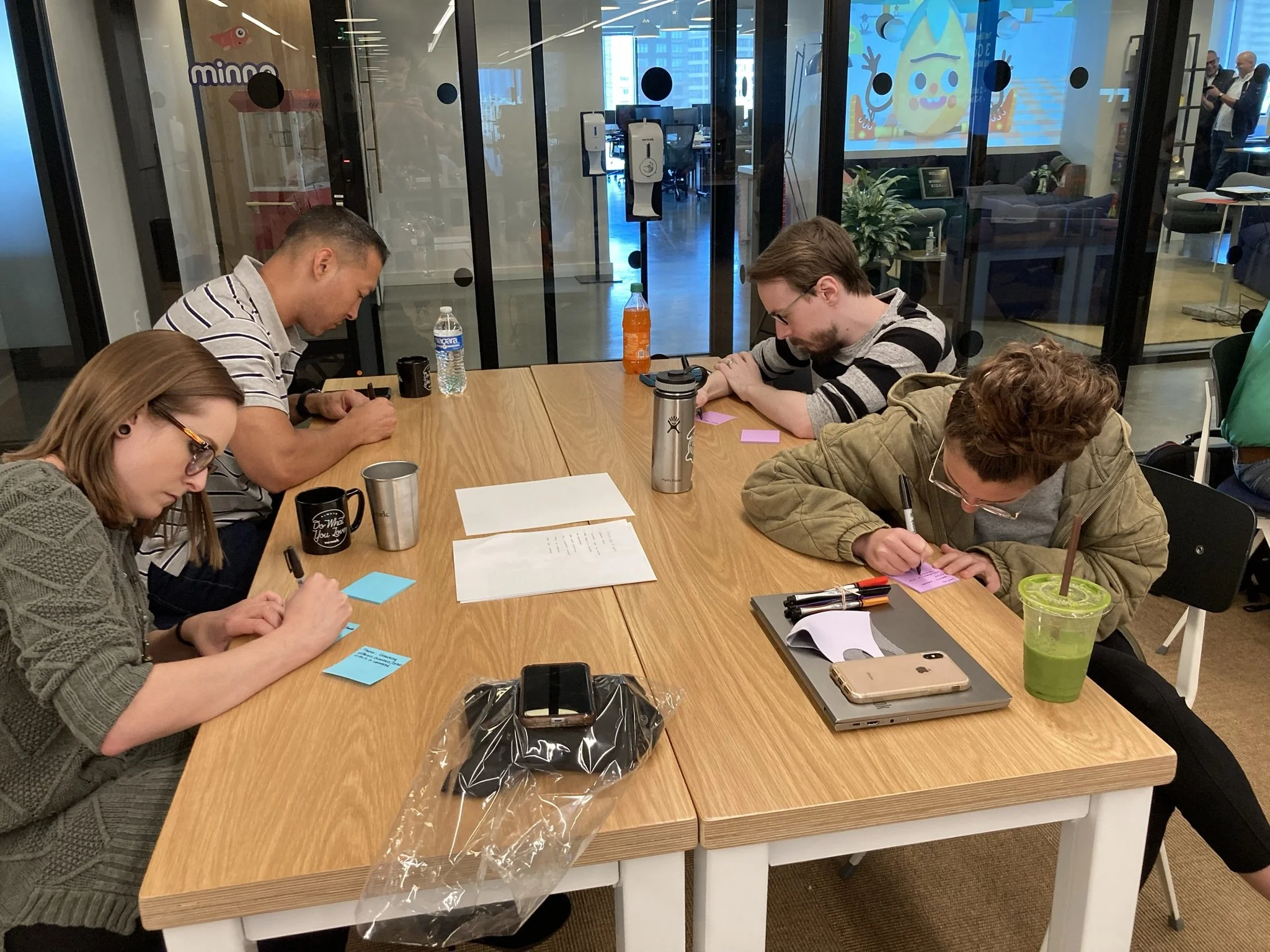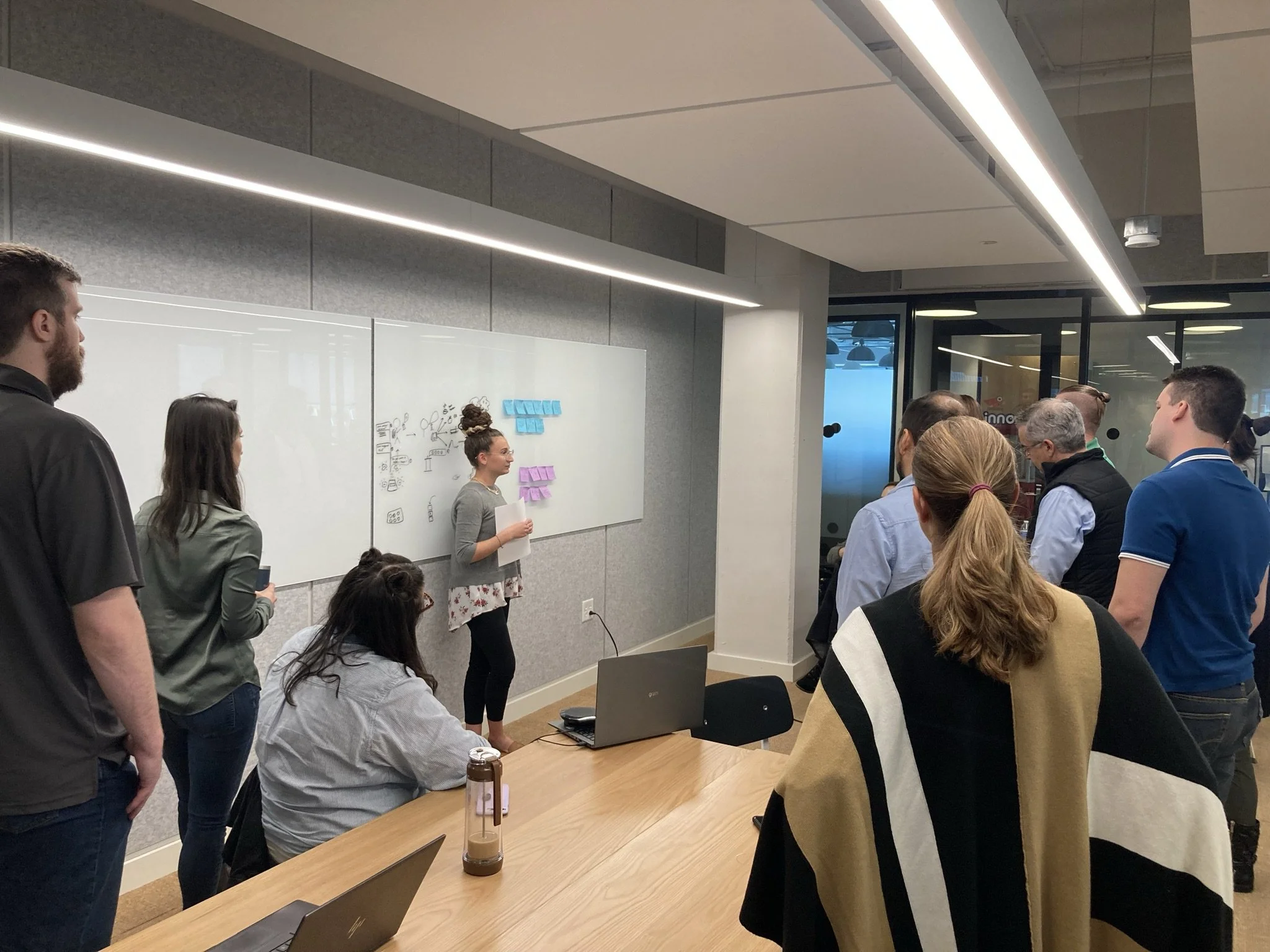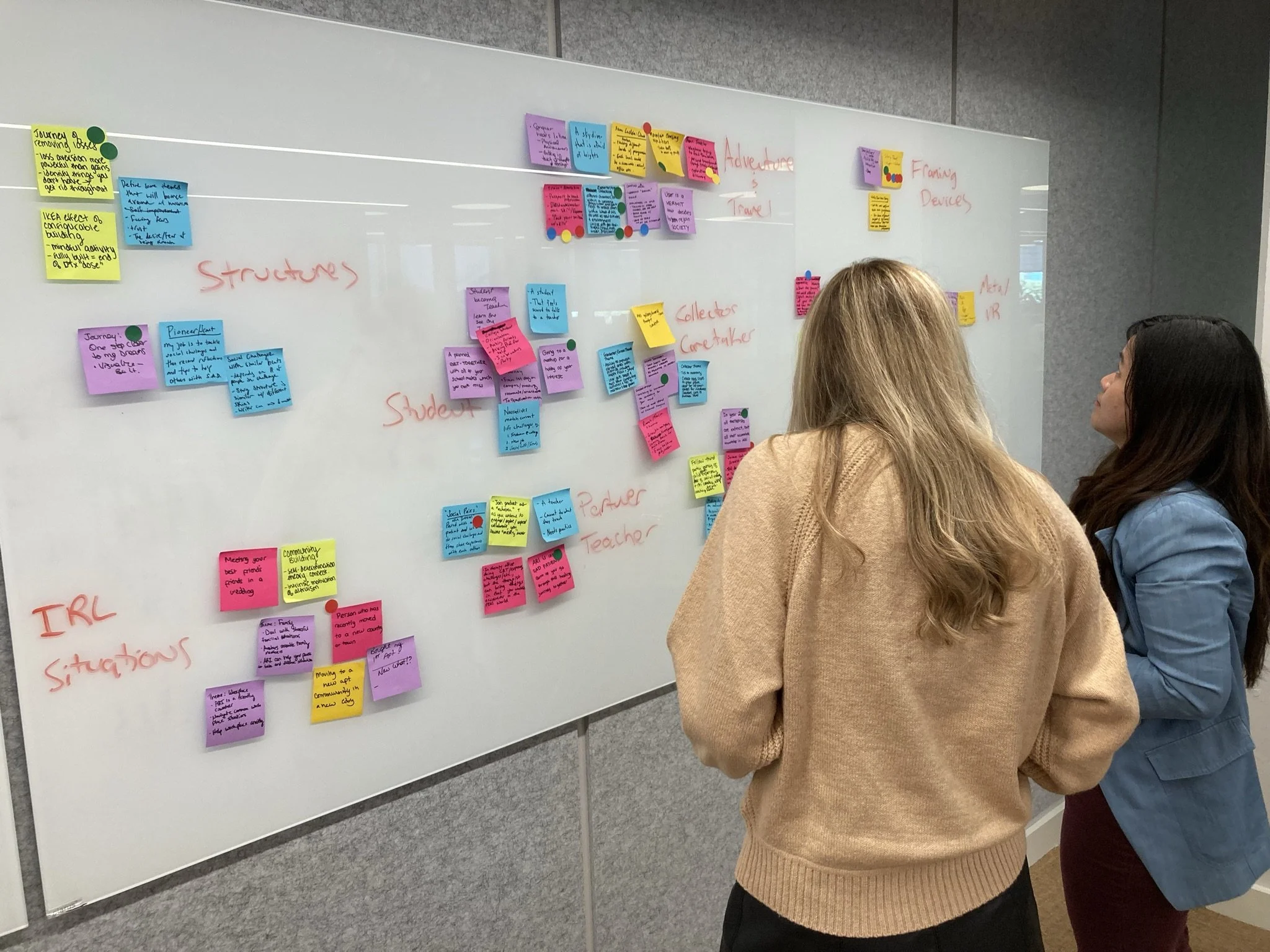Design Facilitation & Research
BehaVR Onsite Design Workshop
Context
BehaVR is building a XR program to assist with treatment of social anxiety, featuring a wide range of mechanics ranging from video content to narrative XR experiences. After a successful run of playtesting our MVP, we found that although the individual experiences were working well, we needed a way to gel the disparate mechanics into a more cohesive long term user experience.
Process
I was one of two designers responsible for planning and facilitating a two day onsite workshop focused on improving and expanding several aspects of the user experience: engagement and habit forming (via new game mechanics,) user progression, and narrative.
In addition, we wanted to give our client a better understanding of our design process, and make sure we were aligned internally across departments and with our client.
User Empathy Exercise
Since we had participants with varying levels of experience with the product and the design process, we began with a user empathy exercise so we would be on the same page about the issues we were trying to address.
We walked the group through excerpts of interviews with users who suffer from social anxiety, and had the group process those experiences into this format:
When I [habitual situation] I want to [take an action] So I can [achieve a desired result]
This helped the team create a shared language for talking about user needs. Now we had a starting point for the targeted brainstorm activities to generate ideas for each theme.
For the remainder of the two day sessions, we addressed each topic with a series of targeted activities, tailored to the scope and format of the ideas we needed to generate. Here are a few examples:
How Might We We used a "How Might We" exercise to create questions that we could answer with new mechanics. Members of the group were instructed to shout out relevant questions, such as , "How Might We [help the user feel more comfortable taking action]"
Brain Writing In order to answer our How Might We questions, we had breakout groups utilize a brain writing exercise. Each participant writes on an idea for a set period of time, and then passes the idea to the next person, who builds on it.
10 + 10 In order to generate a wide variety of possible progression mechanics, (such as badges, achievement points, etc.) we used a 10 + 10 activity. Each group generates around 10 sketches or ideas. Then they use 1 of those ideas as the starting point for a second round. At the end of the activity, each group ends up with around 10 rough ideas, and one idea fleshed out with variations or additional detail.
Narrative Mind Map We closed the workshop with a simply mind mapping activity to come up with a narrative or setting that would tie together the new mechanics and progression systems we had been working on. Participants wrote new ideas on sticky notes, and facilitators grouped them into general themes in real time as they were presented to the group.
Outcome
I was responsible for collating the outcomes of the workshop into approachable workstreams. I distilled most energizing ideas into specific tracks:
"Tactile" progression (rewards that user could interact with in vr) eg collectibles
Symbolic progression (points & achievements, in companion app)
Daily login interactions (check ins)
Reminders & Calls to Action
Hints and Feedback
New Game Mechanics
I generated next steps for Design Team and Product Team, with the target deliverable being testable prototypes within each category.
Final result was the scaffolding for the following 6 months of sprints. Having all participated in this kickoff process, and with the resulting clear and simple design goals serving as a north star, we could more easily communicate the intention of these sprints to the client and executive team.
The Escape Game - Guest Experience Research
Retail Lobby, TEG Chicago
Immersive Lobby Designed for Flagship game Ruins
Context
The Escape Game planned a massive expansion of store locations nationwide and needed a better understanding of their target customer within a compressed timeline. Designs for future stores reflected a hypothesis that stores needed more production value and flair as soon as guests entered the lobby in order to intrigue and hook them into the experience.
Process
I proposed, planned, and led an accelerated user research sprint targetings store guests across three tiers of operation: small walk-in mall locations, medium outlet stores, and flagship destinations. To cover each tier, I visited stores in Nashville, Minneapolis, Chicago, and Houston.
My team performed user research at each location consisting of entry and exit interviews, hidden observation, and “undercover” visits where we visited the store anonymously and played through a game.
I collated responses and observations into a Customer Journey Map, with highlights for each tier of the store. I then presented our findings to the marketing and operations teams and facilitated brainstorm sessions to inform the redesign of new stores.
Outcome
We learned that a guests’ impression of The Escape Game depended on the tier of the store: walk-in guests in a mall location might not know what an escape game is, for example, while flagship locations attracted guests flying in specifically to play our games, and who therefore needed less onboarding and were more open to immersive experience upfront. As a result, we saved our “immersive Lobby” experiences for our flagship stores and streamlined smaller stores to allow game guides to introduce the concept to new guests, significantly reducing the proposed budget needed to launch new stores.
The Escape Game - Game Team Organization & Process Workshop
Context
The game design team at TEG was facing communication issues and decision-making bottlenecks that were disrupting the development of multiple games with looming launch dates, and damaging morale. I worked with department heads to seek solutions.
Process
In order to assess the issue, I performed interviews with the game team to establish what bottlenecks and issues they were facing. Using these findings as a starting point, I facilitated a 2-day workshop with the game team and department heads, using a series of brainstorming and working sessions to identify solutions to the structural issues our team faced and how we might implement those solutions amidst ongoing projects.
Outcome
The workshop helped us identify underutilized skills and desires of each team member. The Game Department Director was able to leverage these insights and empower team members to make decisions within their specific field, significantly reducing decision-making bottlenecks and increasing trust. These changes contributed to the timely redesign of the flagship game, Ruins, so that it could be installed on-time in new locations.







